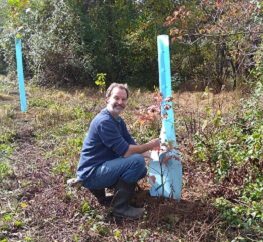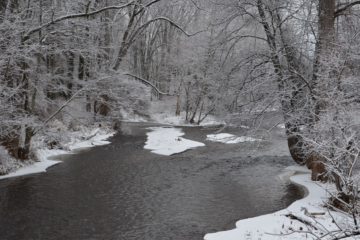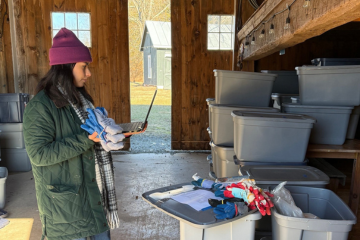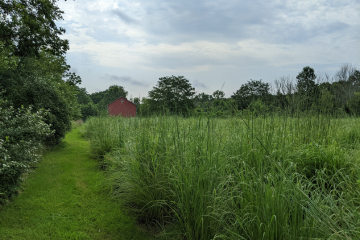
John Kappler
Raritan Headwaters Association (RHA), the watershed watchdog serving the upper Raritan River region, will plant 10,000 native trees and assist with dam removals as part of a large, connected series of projects along the Raritan River and its tributaries to restore water resources, improve wildlife habitats, and increase recreation opportunities.
RHA has been chosen for a $525,000 grant by the “Natural Resource Trustees” overseeing a $25 million-plus Raritan River Watershed restoration project to compensate for environmental damages at a Superfund site in South Plainfield. The Trustees are comprised of representatives of the U.S. Fish and Wildlife Service, National Oceanic and Atmospheric Administration (NOAA), and New Jersey Department of Environmental Protection (NJDEP).
The Trustees are working with over 150 local partners, including Raritan Headwaters and other nonprofit environmental groups, to plan and implement the restorations.
“It’s an enormous project with huge public benefits, and Raritan Headwaters Association is excited to be part of it,” said Cindy Ehrenclou, executive director of RHA. “Planting 10,000 trees along the flood plain of the Raritan River’s North Branch will help control flooding, stabilize stream banks, reduce sediment washing into the river during storms, and keep water temperatures cooler to provide better fish habitat.”
Removing or modifying dams on the Raritan and its tributaries, she added, will not only improve water quality but also restore passage for the migration of several fish species. “Raritan Headwaters played a key role in removing the Burnt Mills Dam in Bedminster in 2019, and we will use the knowledge and experience we gained to help manage other dam removals,” said Ehrenclou.
Twenty projects proposed
Up to 20 restoration projects, stretching from the South Branch in Hunterdon County to the Raritan River’s main stem in New Brunswick, have been proposed to compensate for environmental damages at the Cornell-Dubilier Superfund site in South Plainfield.
From 1936 to 1962, Cornell-Dubilier manufactured electronic parts and components on a 26-acre industrial site near a Raritan River tributary. Hazardous chemicals, including PCBs, were released and buried at the site, contaminating soils, groundwater and nearby streams. As part of a Natural Resource Damages settlement, the Trustees are acting on behalf of the public to restore, replace, or acquire the equivalent of resources affected by contamination.
Planned projects include:
• Up to eight dam removals along the Raritan River main stem and the river’s North and South Branches;
• A nature-like fishway installation to support fish passage in the Raritan River mainstem;
• Riparian restorations along large swaths of the North Branch and Lake Manalapan;
• The creation of the new nature park, boat launch, and fishing platform in the Lost Valley section of Manville;
• Pond removals and freshwater wetland restoration in the Rockaway Creek watershed;
• Freshwater mussel conservation and enhancement in the North Branch and Stony Brook;
• The restoration of freshwater wetlands and native swamp pink lilies in East Brunswick;
• Green infrastructure installations in the Stony Brook watershed;
• Universally accessible walking trails at the Rutgers Ecological Preserve in New Brunswick;
• A new pedestrian trail connection between the Delaware & Raritan Canal towpath and Boyd Park in New Brunswick; and
• Trash trap installations in the lower Raritan River.
Raritan Headwaters will be the main partner in charge of restoring riparian corridors along the North Branch by buffering the flood plain with native vegetation like trees, shrubs, and grasses. These plants help reduce the intensity and “flashiness” of flood events by slowing down runoff that drains to rivers during rain events. The buffers also improve water quality by intercepting chemical pollutants such as lawn fertilizers. Overhanging trees lower stream water temperatures by providing shade, which benefits aquatic wildlife.
The North Branch and its tributaries supply drinking water to over 1.8 million New Jersey residents and provide homes to numerous imperiled aquatic species, yet there are many sections of river that have no vegetative buffers, even in publicly owned sections. The riparian buffer restoration project will provide Raritan Headwaters with funds to identify, prioritize, and implement vegetative buffer restoration throughout the North Branch watershed, with a minimum goal of establishing 10,000 native trees on public lands.
“Clean drinking water and flood protection are essential to both human and wildlife communities, and we’re looking forward to being part of this important project,” said Ehrenclou. “It’s especially critical because of the extreme weather, specifically the increase in the amount of precipitation New Jersey is experiencing.”
Work is expected to begin in 2022 and take four years to complete.
To find out more about the Raritan River Watershed restoration plans, see the U.S. Fish and Wildlife Service’s story map that describes the selected projects in pictorial detail here.



